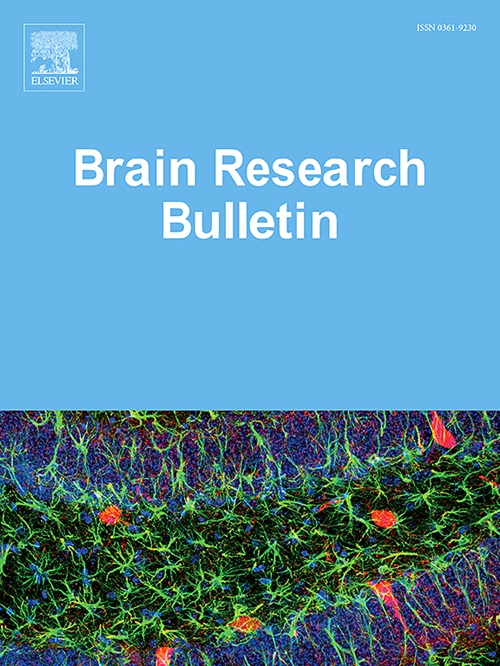EEG microstate in people with different degrees of fear of heights during virtual high-altitude exposure
IF 3.5
3区 医学
Q2 NEUROSCIENCES
引用次数: 0
Abstract
Previous neuroimaging studies based on electroencephalography (EEG) microstate analysis have identified abnormal neural electric activity in patients with psychiatric diseases. However, the microstate information in individuals with different degrees of fear of heights (FoH) remains unknown so far. The aim of the study was therefore to explore the changes of EEG microstate characteristics in different FoH individuals when exposed to high-altitude stimulated by virtual reality (VR). First, acrophobia questionnaire (AQ) before the experiment and 32-channel EEG signals under the virtual high-altitude exposure were collected from 69 subjects. Second, each subject was divided into one of three levels of FoH including no-FoH, mild or moderate FoH (m-FoH) and severe FoH (s-FoH) groups according to their AQ scores. Third, using microstate analysis, we transformed EEG data into sequences of characteristic topographic maps and computed EEG microstate features including microstate basic parameters, microstate sequences complexity and microstate energy. Finally, the extracted features as inputs were sent to train and test an support vector machine (SVM) for classifying different FoH groups. The results demonstrated that five types of microstates (labeled as A, B, C, D and F) were identified across all subjects, of which microstates A-D resembled the four typical microstate classes and microstate F was a non-canonical microstate. Significantly decreased occurrence, coverage and duration of microstate F and transition probabilities from other microstates to microstate F in m-FoH and s-FoH groups were observed compared to no-FoH group. It was also demonstrated that both m-FoH and s-FoH groups showed a notable reduction in sample entropy and Lempel-Ziv complexity. Moreover, energies of microstate D for m-FoH group and microstate B for s-FoH group in right parietal, parietooccipital and occipital regions exhibited prominent decreases as comparison to people without FoH. But, no significant differences were found between m-FoH and s-FoH groups. Additionally, the results indicated that AQ-anxiety scores were negatively correlated with microstate basic metrics as well as microstate energy. For classification, the performance of SVM reached a relatively high accuracy of 89 % for distinguishing no-FoH from m-FoH. In summary, the findings highlight the alterations of EEG microstates in people with fear of heights induced by virtual high-altitude, reflecting potentially underlying abnormalities in the allocation of neural assemblies. Therefore, the combination of EEG microstate analysis and VR may be a potential valuable approach for the diagnosis of fear of heights.
不同恐高程度的人在虚拟高空暴露过程中的脑电图微状态。
以往基于脑电图(EEG)微状态分析的神经影像学研究发现了精神疾病患者的异常神经电活动。然而,不同程度恐高症(FoH)患者的微状态信息至今仍不为人知。因此,本研究旨在探讨不同恐高症患者在受到虚拟现实(VR)的高空刺激时脑电图微状态特征的变化。首先,收集了 69 名受试者实验前的恐高症问卷(AQ)和虚拟高海拔环境下的 32 通道脑电信号。其次,根据每个受试者的 AQ 得分,将其分为无恐高症、轻度或中度恐高症(m-FoH)和重度恐高症(s-FoH)三个级别。第三,通过微状态分析,我们将脑电图数据转化为特征地形图序列,并计算脑电图微状态特征,包括微状态基本参数、微状态序列复杂度和微状态能量。最后,我们将提取的特征作为输入,对支持向量机(SVM)进行训练和测试,以对不同的 FoH 组别进行分类。结果表明,在所有受试者中识别出了五种类型的微状态(标记为 A、B、C、D 和 F),其中微状态 A-D 与四种典型的微状态类别相似,而微状态 F 则是一种非典型微状态。与无 FoH 组相比,观察到 m-FoH 组和 s-FoH 组微态 F 的出现率、覆盖率和持续时间以及从其他微态过渡到微态 F 的概率均显著降低。研究还表明,m-FoH 和 s-FoH 组都显著降低了样品熵和 Lempel-Ziv 复杂性。此外,在右顶叶、顶枕叶和枕叶区域,m-FoH 组的微态 D 和 s-FoH 组的微态 B 的能量与无 FoH 的人相比明显下降。但是,m-FoH 组和 s-FoH 组之间没有发现明显差异。此外,研究结果表明,AQ-焦虑评分与微状态基本指标和微状态能量呈负相关。在分类方面,SVM 在区分无焦虑和有焦虑组时达到了 89% 的较高准确率。总之,研究结果强调了虚拟高空诱发的恐高症患者脑电图微状态的改变,反映了潜在的神经组合分配异常。因此,脑电图微状态分析与虚拟现实技术的结合可能是诊断恐高症的一种有价值的方法。
本文章由计算机程序翻译,如有差异,请以英文原文为准。
求助全文
约1分钟内获得全文
求助全文
来源期刊

Brain Research Bulletin
医学-神经科学
CiteScore
6.90
自引率
2.60%
发文量
253
审稿时长
67 days
期刊介绍:
The Brain Research Bulletin (BRB) aims to publish novel work that advances our knowledge of molecular and cellular mechanisms that underlie neural network properties associated with behavior, cognition and other brain functions during neurodevelopment and in the adult. Although clinical research is out of the Journal''s scope, the BRB also aims to publish translation research that provides insight into biological mechanisms and processes associated with neurodegeneration mechanisms, neurological diseases and neuropsychiatric disorders. The Journal is especially interested in research using novel methodologies, such as optogenetics, multielectrode array recordings and life imaging in wild-type and genetically-modified animal models, with the goal to advance our understanding of how neurons, glia and networks function in vivo.
 求助内容:
求助内容: 应助结果提醒方式:
应助结果提醒方式:


